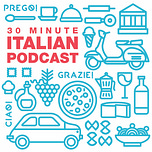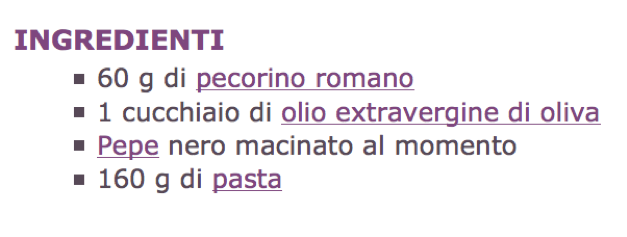Note: This episode is from the archives of the 30 Minute Italian Podcast. All of the links mentioned regarding The Iceberg Project in the episode are no longer active. If you have a question about where to find a resource, read the show notes below or leave a comment so I can help you find something similar!
We stood in the kitchen over a bowl filled with flour, sugar, milk, and eggs.
“And then you ‘mescolare’,” my friend said to me while holding up the whisk.
“Mescolare,” I repeated, writing the verb down in my notebook.
He finished mixing, turned to me, and held up two eggs, “What are these called?”
I crinkled my forehead and thought for a moment, “Le uova!”
“Brava,” he said.
This is how I started learning how to talk about cooking in Italian.
Mind you, I didn’t learn how to cook, but if I watched someone, I knew the words to describe what they were doing.
After I returned home from Italy, I would look up pasta recipes on Giallo Zafferano, Lo spicchio d’aglio, and watch cooking shows in Italian, like the ones on Alice.
All of this craze about cooking words showed me that the kitchen is an entirely new playground for learning the language and getting yourself fed.
With that said, we're going to discuss two recipes in Italian from the website Lo spicchio d’aglio.
The first is a pasta recipe, and we’ll discuss a dessert recipe in a second article next week so you can get a good understanding of the types of words used and how the instructions are presented.
Pasta cacio e pepe
Find the recipe here: Pasta cacio e pepe
Just like every other recipe, you’ll see a list of the ingredients, and if you’re reading an Italian recipe, you’ll have to use metric measurements.
So here we have
60 grams of pecorino cheese (1/4 cup)
1 tablespoon of extra virgin olive oil
Ground black pepper at the moment (fresh ground black pepper)
160 grams of pasta (around 6 ounces or a third of a box of pasta)
Then you’ll read some basic information about the recipe.
It’s enough for two people, has 450 kilocalories, easy difficulty, ready in 45 minutes, vegetarian recipe, and a light recipe.
CPF: Kilocalories are the same as calories. We just use a different word in the US.
Then you’ll see how to prepare the recipe.
Verbs to know are:
Grattugiare – To grate
Grattugiare il pecorino – To grate the pecorino
Tenere – To keep
…tenerne da parte una manciata per decorare – Keeping a handful apart for decorating
Mettere – To put
…e mettere il resto in una ciotola - …and putting the rest in a bowl
Mettere nei piatti – To put on the plates
CPF: Notice how it’s not “sui” (on) piatti as we might say in English. It would literally be “in the plates.”
Preparare – To prepare
Prepare una padella abbastanza ampia da condirci la pasta – Prepare a pan ample enough to season the pasta
Lessare – To stew
Lessare la pasta in abbondante acqua salata – Stew the pasta in plenty of salted water
Aggiungere – To add
…aggiungere un mestolo di acqua di cottura nella ciotola con il pecorino – To add a spoonful of boiled water in the bowl with the pecorino
Mescolare – To mix
…mescolando con una frusta fino ad ottenere una cremina densa – Mixing with a whisk until obtaining a dense cream
Accendere – To light up
Accendere il fuoco sotto la padella – Light up the fire under the pan
Scolare – To strain/drain
Scolare la pasta – To drain the pasta
Unire – To combine
Unire la crema di pecorino e mescolare accuratamente – Combine the pecorino cream and mix carefully
Spegnere – To turn off
Spegnere il fuoco se il formaggio tende ad addensarsi troppo. – Turn off the fire if the cheese starts to thicken too much.
Cospargere – To sprinkle
…cospargere con il pecorino tenuto da parte – Sprinkle with the pecorino kept apart
Want to learn how to make desserts from Italian recipes too? Click here.
Some other great vocabulary words to know are:
Manciata – Handful, fistful
Macinato – Ground, minced
Ciotola – Bowl, dish
Mestolo – Spoonful
Frusta – Whisk
Padella – Pan
Tritare – Mince, chop up
A scaglie – Flakes
Condire – Season, spice
Girare – Turn upside down (like when you are cooking a fish fillet) / to mix (more informal: ‘gira il sugo, o si attacca alla pentola! – Mix the sauce, or it will stick to the bottom of the pan)
Cucchiaio – Spoon
Forchetta – Fork
Rompere (le uova) – To (not sure what you say in English for ‘breaking/opening’ the eggs)
Sbattere – To beat (like beating the eggs with a fork)
Separare – To divide (e.g. the egg white from the egg yolk)
Sbucciare – To peal (of veggies and fruits with a thick skin, like an orange, but sometimes used also for apples, potatoes, onions, peas, corn)
Pelare – To peal (of veggies and fruits with a thinner skin. Mainly used for potatoes and carrots)
Tagliare – To cut


















Share this post